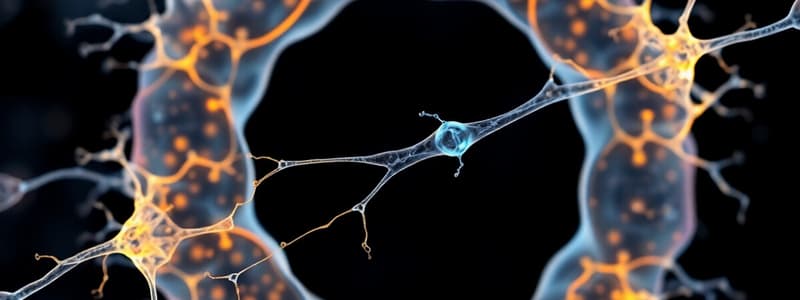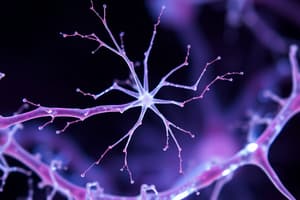Podcast
Questions and Answers
What is the primary structural component of microfilaments?
What is the primary structural component of microfilaments?
- Collagen
- Actin (correct)
- Keratins
- Tubulin
Which characteristic is associated with intermediate filaments?
Which characteristic is associated with intermediate filaments?
- They provide mechanical strength and resistance to shear stress. (correct)
- They are constructed from a single type of protein.
- They are soluble and dynamic in nature.
- They are primarily involved in cell movement.
Which function is NOT associated with the cytoskeleton?
Which function is NOT associated with the cytoskeleton?
- Energy production (correct)
- Maintaining cell shape
- Intracellular transport of organelles
- Cell division
What role do kinesins and dyneins play in the cytoskeleton?
What role do kinesins and dyneins play in the cytoskeleton?
What structure do cilia and flagella utilize for movement?
What structure do cilia and flagella utilize for movement?
Which of the following statements about microtubules is true?
Which of the following statements about microtubules is true?
Centrioles are primarily associated with which process in eukaryotic cells?
Centrioles are primarily associated with which process in eukaryotic cells?
Which type of cytoskeletal filament is characterized by its role in stabilizing organelles?
Which type of cytoskeletal filament is characterized by its role in stabilizing organelles?
What is the main structural pattern observed in cilia and flagella?
What is the main structural pattern observed in cilia and flagella?
How do cilia move in comparison to flagella?
How do cilia move in comparison to flagella?
What denotes a significant difference between eukaryotic and prokaryotic flagella?
What denotes a significant difference between eukaryotic and prokaryotic flagella?
Which components make up the structure of a flagellum?
Which components make up the structure of a flagellum?
In eukaryotic cells, how do the lengths of cilia and flagella typically compare?
In eukaryotic cells, how do the lengths of cilia and flagella typically compare?
What type of movement do flagella exhibit?
What type of movement do flagella exhibit?
What is the function of dynein in the structure of flagella and cilia?
What is the function of dynein in the structure of flagella and cilia?
Which structural element is NOT found in both cilia and flagella?
Which structural element is NOT found in both cilia and flagella?
What is the primary function of microtubules in a cell?
What is the primary function of microtubules in a cell?
Which component forms a meshwork that stabilizes the inner nuclear membrane?
Which component forms a meshwork that stabilizes the inner nuclear membrane?
How are centrioles organized?
How are centrioles organized?
What role do microtubules play in cell division?
What role do microtubules play in cell division?
Which of the following cellular components primarily provides mechanical strength to muscle cells?
Which of the following cellular components primarily provides mechanical strength to muscle cells?
Where are centrioles primarily located in an animal cell?
Where are centrioles primarily located in an animal cell?
What is the primary structural configuration of a microtubule?
What is the primary structural configuration of a microtubule?
What is a key function of the basal bodies derived from centrioles?
What is a key function of the basal bodies derived from centrioles?
Flashcards
Cilia and Flagella
Cilia and Flagella
Hair-like projections from a cell's surface that aid in movement, found in eukaryotes (e.g. cells in our body).
Eukaryotic Flagella
Eukaryotic Flagella
Eukaryotic flagella are different from prokaryotic ones, with a unique structure.
Microtubule Arrangement
Microtubule Arrangement
Eukaryotic cilia and flagella have an internal structure containing 9 pairs of microtubules arranged around 2 central microtubules.
Cilia vs. Flagella (Length)
Cilia vs. Flagella (Length)
Signup and view all the flashcards
Cilia Movement
Cilia Movement
Signup and view all the flashcards
Flagellum Movement
Flagellum Movement
Signup and view all the flashcards
Flagellum Shaft
Flagellum Shaft
Signup and view all the flashcards
Dynein
Dynein
Signup and view all the flashcards
Cytoskeleton
Cytoskeleton
Signup and view all the flashcards
What are the 3 types of cytoskeletal fibers?
What are the 3 types of cytoskeletal fibers?
Signup and view all the flashcards
Actin Filaments
Actin Filaments
Signup and view all the flashcards
Intermediate Filaments
Intermediate Filaments
Signup and view all the flashcards
Microtubules
Microtubules
Signup and view all the flashcards
What is the purpose of the mitotic spindle?
What is the purpose of the mitotic spindle?
Signup and view all the flashcards
Dyneins and Kinesins
Dyneins and Kinesins
Signup and view all the flashcards
What is the role of the cytoskeleton in cell movement?
What is the role of the cytoskeleton in cell movement?
Signup and view all the flashcards
Keratin
Keratin
Signup and view all the flashcards
Nuclear Lamins
Nuclear Lamins
Signup and view all the flashcards
Neurofilaments
Neurofilaments
Signup and view all the flashcards
Vimentins
Vimentins
Signup and view all the flashcards
Centriole Function
Centriole Function
Signup and view all the flashcards
Basal Bodies
Basal Bodies
Signup and view all the flashcards
Microtubule Triplets
Microtubule Triplets
Signup and view all the flashcards
Study Notes
Cellular Structural Support
- The cytoskeleton is a network of fibers throughout the cell's cytoplasm.
- Eukaryotic cells contain protein fibers that provide cell structure and shape, providing mechanical strength and facilitating cell movement, chromosome separation, and intracellular transport of organelles.
- Intercellular transport is associated with dyneins and kinesins.
- These transport organelles like mitochondria or vesicles and are reponsible for moving vesicles and organelles.
- Kinesin protein walks on microtubules to carry out intercellular transport.
- The role of the mitotic spindle is to help align and separate chromosomes.
Functions of Cytoskeleton
- The cytoskeleton provides cell shape, organelle movement, cell movement, and cell division.
- In animals, the cytoskeleton also keeps cells together, which maintains cells functioning, and ultimately contributes to overall animal health.
The Self-Assembly and Dynamic Structure of Cytoskeletal Filaments
- Three types of macromolecular fibers make up the cytoskeleton: Actin Filaments (also called microfilaments), Intermediate Filaments, and Microtubules.
- Extra proteins (such as motor proteins) assist the functions associated with each of these filaments.
- Each filament type has distinct mechanical properties and dynamics.
Microfilaments/Actin Filaments
- Microfilaments are little strands made of proteins called actin.
- The microfilament within the cytoskeleton is in the shape of a double helix.
- Microfilaments are mostly found in the cortex, just beneath the plasma membrane.
Intermediate Filaments
- Intermediate filaments are insoluble proteins that help form the cell's cytoskeleton system, the internal framework that gives a cell its shape.
- Intermediate filaments have a structure of two antiparallel helices forming "ropelike” fibers.
- Intermediate filaments stabilize organelles.
- Keratins are found in epithelial cells, hair and nails.
- Nuclear lamins form a meshwork that stabilizes the inner nuclear membrane.
- Neurofilaments strengthen the long axons of neurons.
- Vimentins provide mechanical strength to muscle and other cells.
- Intermediate filaments provide strength and resistance to stress.
- There are several types, each constructed from one or more proteins.
Microtubules
- Microtubules are intracellular structures shaped like long cylinders or tubes made of protein tubulin.
- The microtubules participate in a wide variety of cell activities, including motion (using ATP powered protein motors), determining the positions of membrane-enclosed organelles, and directing intracellular transport.
- The migration of chromosomes during mitosis and meiosis occurs on microtubules that form spindle fibers.
Microtubular Arrays: Centrioles
- Centrioles are short, hollow cylinders.
- They are made of 27 microtubules arranged into 9 overlapping triplets.
- One pair per animal cell.
- Located in the centrosome of animal cells, oriented at right angles to each other.
- Separate during mitosis to determine the plane of cell division.
- May give rise to basal bodies of cilia and flagella.
Microtubular Arrays: Cilia and Flagella
- These are hair-like projections from a cell's surface that aid in cell movement.
- Prokaryotic flagella differ from eukaryotic versions.
- The outer covering is the plasma membrane, and the internal structure includes 18 microtubules arranged in 9 pairs, with two single microtubules in the center (a 9 + 2 pattern).
- Cilia are typically shorter than flagella.
- Cilia move in coordinated waves (like oars).
- Flagella move like propellers or corkscrews.
Structure of a Flagellum
- A flagellum has a shaft, a basal body, and a flagellum cross section.
Cilia Motion
- Cilia move like oars.
Cilia and Flagella Ultrastructure
- Both cilia and flagella have a core of microtubules sheathed by the plasma membrane.
Cytoskeleton Filament Diameters
- Microtubules: 25 nm diameter
- Actin filaments: 7 nm diameter
- Intermediate filaments: 10 nm diameter
Cell Connections & Junctions
- Eukaryotic cells contain protein filaments that are collectively called the cytoskeleton.
- These cytoskeleton filaments play a crucial role in the establishment of cellular junctions.
- Cell junctions are the connections between neighboring cells or the contact between a cell and the extracellular matrix.
- This is also called a membrane junction.
- Cell junctions are classified into three types: Occluding/Tight, Communicating, and Anchoring junctions.
Cell Junctions
- Cell junctions aid in cellular communication, help cells stick together to make tissues, and prevent the passage of materials.
Occluding Junctions
- Occluding junctions form impermeable or semi-permeable barriers between cells.
- Tight junctions (zona occludens) closely associate areas of two cells, with their membranes joining, creating a virtually impermeable barrier to fluid.
- A type of junctional complex, only found in vertebrates.
Adherens Junctions
- Desmosomes connect intermediate filaments of one cell to other cells, for cell-to-cell adhesion and to prevent lateral tearing of tissues.
- Hemidesmosomes have a structure similar to half-desmosomes, attaching cells to the underlying basal lamina.
Communicating Junctions (Gap Junctions)
- Gap junctions permit intercellular exchange of substances (e.g., ions and molecules) between cells.
- The exchange occurs through channels (formed from connexins) that connect the cytoplasm of adjacent cells.
Plant Cells: Plasmodesmata
- In plant cells, plasmodesmata perform many of the same functions as gap junctions.
- These are plasma membrane-lined channels that connect adjacent cells.
Summary of Cellular Junctions
- Each junction consists of specific adhesion proteins. Tight junctions seal cells together in epithelial sheets. Adherens junctions link actin bundles between neighboring cells. Desmosomes connect intermediate filaments. Gap junctions allow passage of small water-soluble molecules. Hemidesmosomes attach cells to the basal lamina.
Various Cell Junctions
- Various types of junctions are found in a vertebrate epithelial cell, classified according to their functions (occluding, anchoring, channel-forming).
Studying That Suits You
Use AI to generate personalized quizzes and flashcards to suit your learning preferences.
Related Documents
Description
Explore the critical roles of the cytoskeleton in eukaryotic cells, including its contribution to cell shape, movement, and intracellular transport. This quiz covers the mechanisms of transport proteins like dyneins and kinesins, and the functions of the mitotic spindle during cell division.




